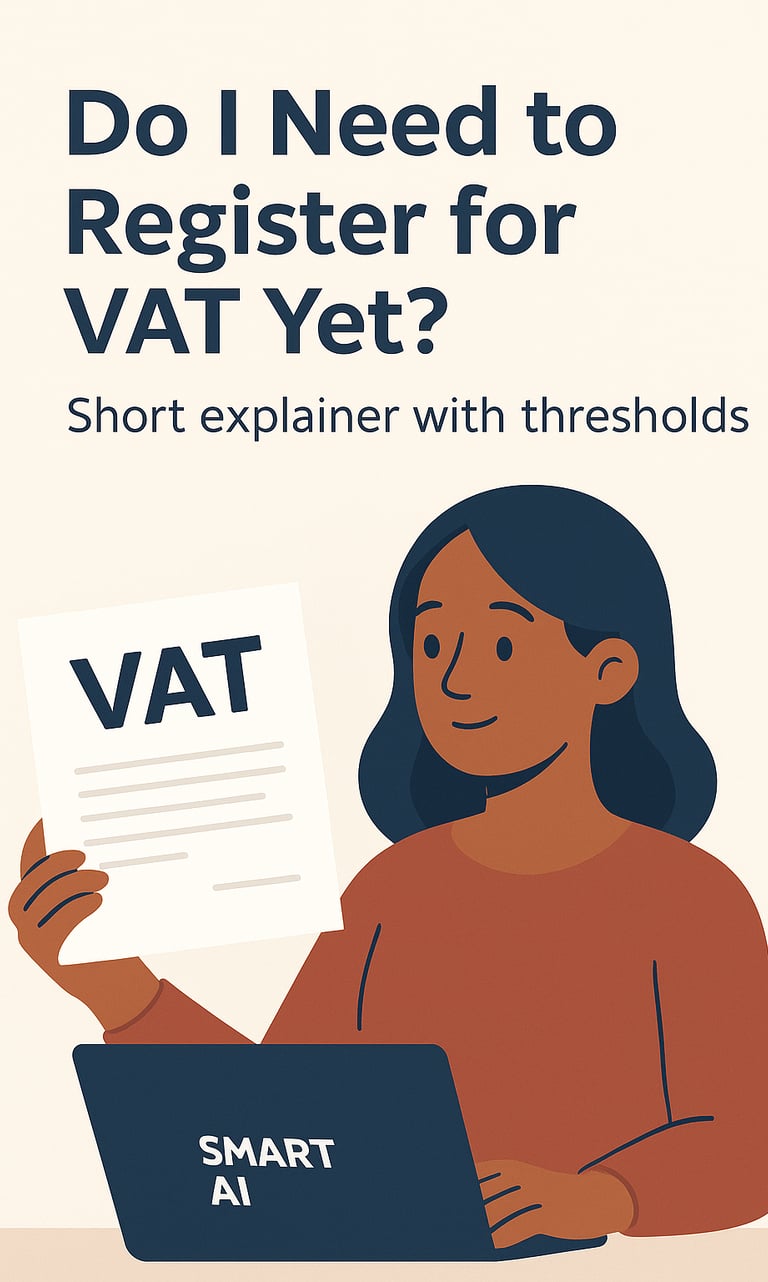Do I Need to Register for VAT Yet?
A simple guide to understanding when and why to register for VAT in the UK. Covers thresholds, key rules, and your options. Ideal for small business owners nearing £90k turnover
VAT
10/25/20253 min read


If you’ve been running your business for a while, or things have recently started picking up, you might be wondering: “Do I need to register for VAT yet?”
It’s a common question — and a good one to ask. Because while registering for VAT can bring some benefits, it also comes with new admin and legal obligations. So, let’s break it down simply.
What is VAT (and Why Should I Care)?
VAT stands for Value Added Tax. It’s a tax charged on most goods and services sold in the UK.
When your business is VAT-registered, you:
Add VAT (usually 20%) to your invoices
File VAT returns (usually every quarter)
Pay VAT you owe to HMRC — or claim it back on expenses
If you’re not VAT-registered, you don’t charge VAT and don’t file VAT returns. But there’s a key trigger that changes that...
The VAT Threshold (The Magic Number: £90,000)
As of 1 April 2024, the VAT registration threshold is £90,000 in rolling turnover.
Here’s what that means:
Look at your total sales (not profit) over any 12-month rolling window
If you go over £90,000, you must register within 30 days
This isn’t based on calendar years. It’s rolling — so every month, look back at the last 12 months.
Example:
Let’s say your turnover from June 2024 to May 2025 totals £92,000. You passed the threshold in May, so you must register and start charging VAT.
What Happens If I Don’t Register?
HMRC doesn’t take kindly to missed registrations. If you go over the threshold and don’t register, you could face:
Penalties and interest on late VAT
Backdated VAT bills (ouch)
A damaged relationship with HMRC
Even if you didn’t mean to avoid VAT, they’ll expect you to correct it quickly. That’s why keeping an eye on your turnover each month matters.
Should I Register Voluntarily?
Here’s where it gets interesting.
You can register before you hit £90,000 — and for some businesses, it actually makes sense.
You might choose to register early if:
You work mostly with VAT-registered businesses who can reclaim the VAT you charge
You have large VATable expenses and want to claim VAT back
You want to appear more established or professional to clients
But it’s not for everyone. If your clients are individuals or charities (who can’t reclaim VAT), they’ll feel the price increase directly.
We usually advise: Wait unless there’s a benefit or you’re close to the threshold. We’ll help you decide.
How Do I Register for VAT?
If you hit the threshold — or choose to register early — here’s what to expect:
Apply online via HMRC (takes 10–30 minutes)
Get your VAT number (usually within 10 working days)
Start charging VAT on your sales
File your first VAT return (typically after 3 months)
Smart AI Accounting can handle all of this for you — including advising on the best VAT scheme for your business.
Flat Rate vs Standard VAT Scheme
Most small businesses use one of two options:
1. Standard VAT Scheme
You charge VAT on sales
You reclaim VAT on purchases
File a detailed VAT return
2. Flat Rate Scheme
You charge VAT (usually 20%)
But you pay HMRC a lower flat rate based on your industry (e.g. 12.5% for IT consultants)
You can’t usually reclaim VAT on purchases (with exceptions)
Flat Rate is simpler and sometimes cheaper — but it depends on your costs. We’ll help you weigh it up.
How We Can Help
At Smart AI, we keep things proactive. Our bookkeeping tools (like Xero) track your sales automatically and alert us if you’re nearing the threshold.
We’ll help you:
Monitor turnover monthly
Decide if and when to register
Choose the right VAT scheme
Register and set up correctly in Xero
Submit your VAT returns accurately and on time
Example: A copywriter client was creeping toward £90,000 but hadn’t noticed. We flagged it early, registered her in time, and helped her switch to the Flat Rate Scheme, saving hours of admin and a chunk of cash.
Quick VAT Checklist
Track your 12-month turnover monthly
Watch for when you cross £90,000 (not calendar year!)
Register within 30 days of hitting the threshold
Decide if voluntary registration suits your business
Choose the best VAT scheme (we’ll guide you)
Keep receipts — VAT on expenses = money back
TL;DR – Do You Need to Register for VAT?
Over £90,000 in any 12-month period? Yes, it’s mandatory.
Close to the threshold or have high VAT costs? Maybe — voluntary might suit you.
Under £90,000 and selling to consumers? Probably not yet.
If you're unsure, don’t guess — we’ll check it for you.
Let’s Make VAT Simple
Not sure if you’re close to the VAT line? Want to avoid nasty surprises? Smart AI clients get proactive alerts, expert guidance, and zero stress.
Book your free VAT check today and take the guesswork out of your taxes.
We’ll review your business position, we’ll walk you through and guide you through your next steps, all in one easy session.
Branding & Message
Social Media
Smart AI Accounting Ltd.
Helping UK small businesses simplify their finances.
© 2025 Smart AI Accounting Ltd. All rights reserved.


Contact Info
📧 info@smartaiaccounting.com
📱 07882 527 345
📍 11 Grinder Close, Salisbury, SP4 7ZL, United Kingdom
🔗 LinkedIn | Facebook
